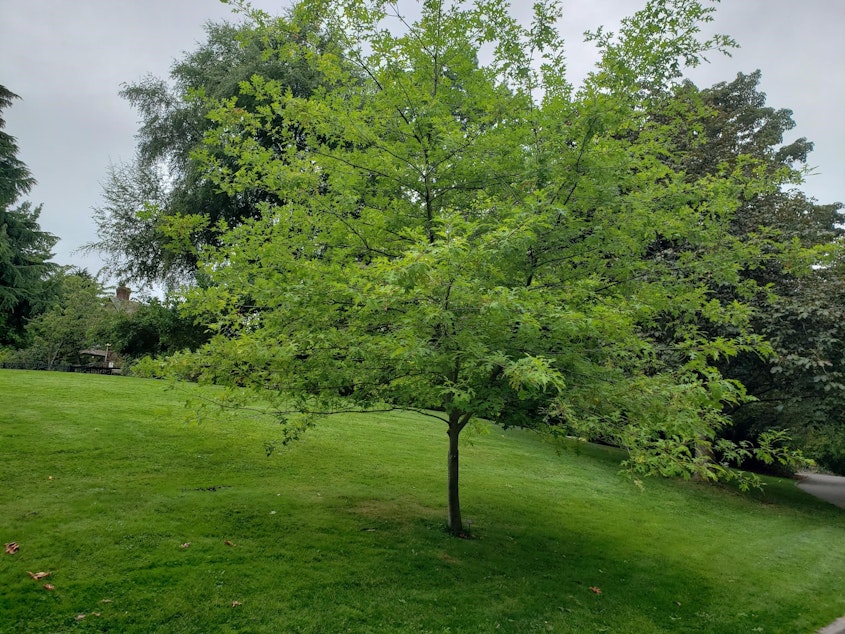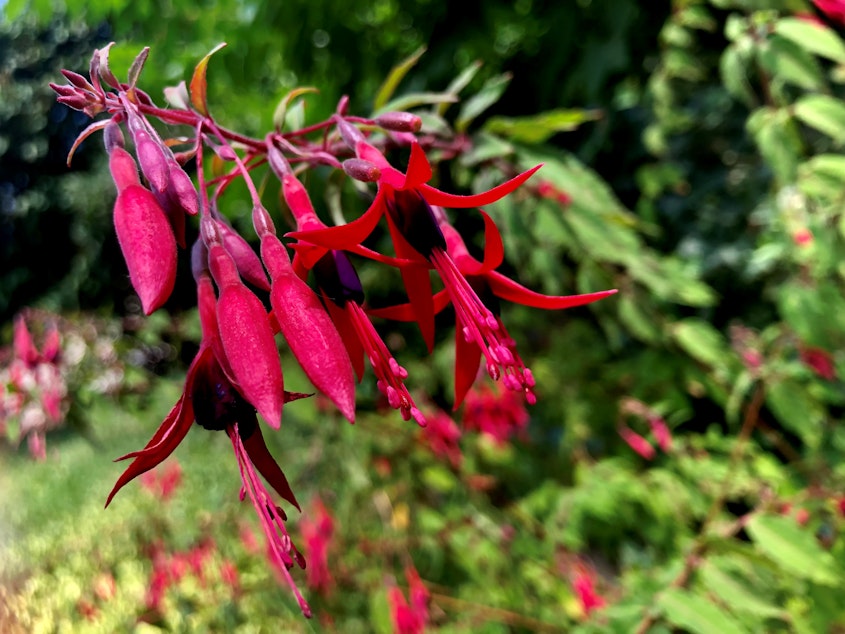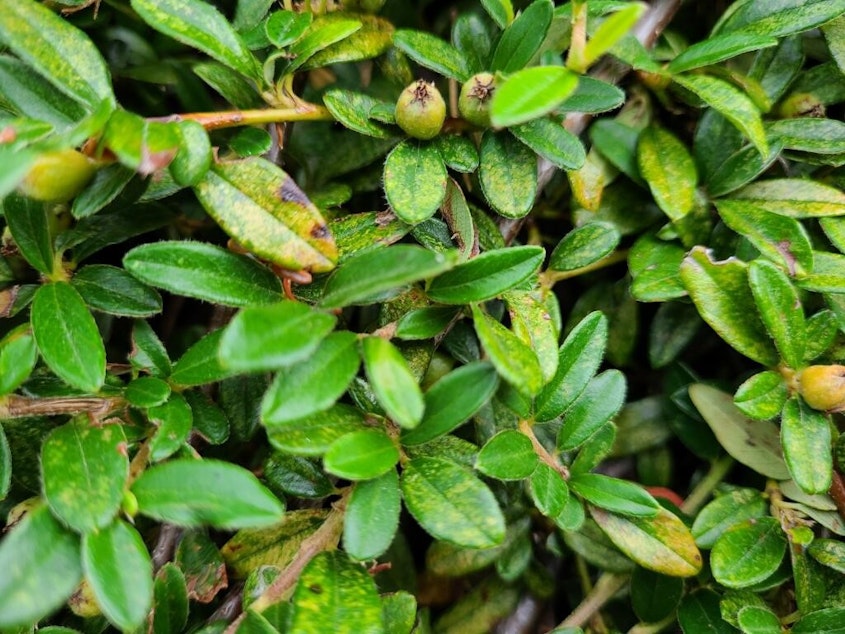Seattle Now: Your garden might be a fire hazard
If you think you're safe from wildfires because you live in the city — think again. Those pine trees and juniper bushes outside your front door could be putting you in danger.
It's been a record-breaking hot and sunny summer in Seattle and around the Pacific Northwest this year. In addition to worrying about climate change, drinking enough water, and staying safe during the pandemic, you might also want to add urban wildfires to your list of things to keep in mind as you navigate this unprecedented landscape of dangers.
In today's episode of Seattle Now, guest-host Paige Browning talks with producer Brandi Fullwood about the risk of wildfires in urban areas of western Washington, and how to make sure your garden is fire-resistant and eco-friendly.
We also hear from Al Murphy, master gardener with Washington State University; Becky Cheney, conservation chair for the Native Plant Society; and Jason Mendel from Mountain to Sound, a home safety inspection company.
The transcript below has been edited for clarity.

PAIGE BROWNING: Is your garden fire-resistant? All plants have the potential to burn, but we can plant some species that are local in preparation for wildfire season. Quite often living in western Washington, we think of rain, we think of moss, we think of the wet side of the state.
Sponsored
AL MURPHY: Gasoline is a heck of a lot more prone to burn than water, right? We have some plants that almost act like gasoline, but the idea is that it's getting drier. It's getting drier; we're seeing less precipitation. So it's not an east side, west side differentiation.
PAIGE BROWNING: We've got KUOW producer Brandi Fullwood here. I'm now wondering, is it really that bad in western Washington? I know there's a lot of concern about the drought in other parts of the state and wildfire concern. But often, we hear that in other places — not in a townhouse in Ballard, or somewhere in Magnolia.
BRANDI FULLWOOD: I definitely felt the same thing too. This is an issue that has been very new to me on different levels. One thing about it as a newcomer to the area, but also someone who wasn't considering wildfire, that much of a risk in Western Washington.
Sponsored
Even right now, with the drought that the state is experiencing, we know that King County, Snohomish County and Pierce County are experiencing abnormal levels of drought, but nothing as severe as the rest of the state.
I reached out to this guy, Al Murphy. He's a master gardener with Washington State University over in the Chelan and Douglas County area, and he's a former firefighter. He said that the west side is at the same risk — if not higher — because of all of the many small fuels in our gardens and in our front yards next to our houses, just the probability of what can catch on fire is higher and we need to think about fires differently here.

AL MURPHY: A lot of times people think, "Well, I don't live on the edge of the forest or the sagebrush or whatever, so I don't have to worry about that." Embers don't care. The vast majority — 70 to 90% —of all homes that burn are ignited by embers that land on or near the house, and they can travel over a mile.
Sponsored
PAIGE BROWNING: Over a mile! Even growing up in Spokane, I lived in Montana, this is wildfire country; I still didn't know that an ember can travel that far. And that makes it feel a little bit closer to home, Brandi. And I know that you're going to tell me that we want to garden to prevent these problems. Can you tell me about this? How does that help?
BRANDI FULLWOOD: It's not just even gardening in general, it's actually making sure your landscaping (and) your garden is fire-resistant. That means planting more herbaceous, green, clean and lean plants. And that could be perennials, that could be annuals, that could be the type of grass you even pick. You just want your probability of what catches on fire to be lower.
PAIGE BROWNING: You know, I'm in an apartment. I don't have a ton of space to garden but I took the liberty this year to plant some edible things like tomatoes. I'm trying a berry bush, and I planted some yarrow because I read that it would help deter pests.
BRANDI FULLWOOD: I think you're in the clear Paige, a lot of what it sounds like you've planted thrives really well in the heat, like your tomatoes. But specifically, yarrow. It's drought resistant and fire resistant. So props to you.
PAIGE BROWNING: OK, so bring on the yarrow garden. What other plants are there Brandi, that people should be thinking of; that are drought or fire resistant?
Sponsored
BRANDI FULLWOOD: It's definitely gonna depend on where you are. And even in western Washington, some people live in more wooded areas, some people live near that wildlife urban interface, and so those plants are different. But generally some good plants are Oregon grape, the basket-of-gold, hollyhock tribes and even fire weed, ironically.
PAIGE BROWNING: Wait, the ones you just said are not flammable, right?
BRANDI FULLWOOD: Yeah, they're the good plants.
PAIGE BROWNING: OK, those are the good plants. What are the bad plants?
BRANDI FULLWOOD: So when I talked to Al Murphy, he said some of our favorites — aesthetically speaking — they can be bad too.

AL MURPHY: For example, there's arborvitae. It's a conifer bush that a lot of people like to have, but it's extremely flammable. So one of the things you want is an open growing plan; you don't want something that's really tight.
PAIGE BROWNING: That's interesting. And you said something earlier, sort of a catchphrase? I think you said you want to have plants that are "green, clean and lean." Is this sort of what you're talking about? You you want them to be lean, not bushy, like your hand closed together.
BRANDI FULLWOOD: Yeah, green, clean and lean. That's exactly what he's talking about. I should also note that with these plants, it's not even just the embers that are sparking, it can be like you've parked your car way too close to dried grass or you have woodchips right in front of your house. I reached out to Becky Cheney, who's the conservation chair for the Washington Native Plant Society. And she even said that wood chips aren't the best idea.
BECKY CHANEY: There's a tendency to for us here to put down wood chips as a mulch everywhere because wood chips are available. Putting them close to the house creates basically kindling right next to your home. Your home is the most combustible place on the lot.

PAIGE BROWNING: Oh my gosh. So I can sort of see this now, you've got a barbecue and something goes awry near the woodchips or as you mentioned, you park your car near the dried grass and something ignites. Okay, so I'm learning a lot. You've learned a lot. Brandi, do you garden?
BRANDI FULLWOOD: I've planted some tomatoes like you, they did quite well in the heatwave. But my partner takes over the garden a lot more than I do. After talking to everyone, I know that we need to be more proactive about the grass. So I kind of want you to listen to this.
PAIGE BROWNING: Are you maybe like... you're opening your produce box? A package? Wait, wait, wait, wait, what is this?
BRANDI FULLWOOD: It's my lawn.
PAIGE BROWNING: No, it's so crunchy!
BRANDI FULLWOOD: Yeah, it's very crunchy, it's very dry. And I even invited inspector Jason Mendel from Mountain to Sound to assess this. We're at my house. I live in North Queen Anne. We're standing on my porch and my grass is very dead. When you walk up, what's the first thing you notice? Or the first thing that you could tell me about what's hazardous about about this home?

JASON MENDEL: I'm just looking at the outside. For this home itself, now, I don't really see anything that's considered a fire-related issue like that. It's summertime right now. So of course the grass is dry and dead which makes an extreme fire hazard. So looking at the front here, you've got these rose bushes and plants up here, and these are all nice and close and actually touching the home and the siding and stuff like that. These are things that we like to keep at least a foot away from the house.

PAIGE BROWNING: Brandi, this is just something I don't hear about, the words "extreme fire risk" and "North Queen Anne" in the same sentence. I haven't been to your house yet—still waiting for an invite, but I know it's gonna take a lot of water to get that crunchy grass back to green at your place. So watering doesn't necessarily sound like a solution for fireproofing.
BRANDI FULLWOOD: No, and I don't think even most of the people I spoke to really suggested over watering the grass. That's a lot of water, especially in the middle of a drought. Even Al Murphy said it can be a balance at times because ultimately, not burning your neighborhood is also important. But Becky Chaney, that conservation chair from the Washington Native Plant Society, she came through with some alternatives for grass.
BECKY CHANEY: So you want to think about what do you do instead of grass. Our sword ferns can accumulate dead fronds underneath. If you have them close to your house, you may be wanting to trim those off, but otherwise they are very well adapted to our area. I would personally go for them before any of our ornamental grasses.
BRANDI FULLWOOD: She also suggested kinnikinnick and even letting the moss come through. I know a lot of people are into the aesthetic looks of their lawn, but don't be afraid of moss growing in your grass.

PAIGE BROWNING: So lean into kinnikinnick and that moss life.
BRANDI FULLWOOD: Yeah, #mosslife.
PAIGE BROWNING: Brandi, not everyone owns a home, let alone has enough money to revamp their entire garden. So what do they do?
BRANDI FULLWOOD: So full disclosure, I'm also not a homeowner but we are in charge of maintaining the grounds . But very small maintenance things: clearing out your gutter, trimming the trees, clearing out debris. Jason Mendell, the inspector who came to my house and proclaimed my lawn a fire hazard, also gave me some other suggestions about what we should be doing around the house.
PAIGE BROWNING: Okay, so you've just added to my weekend to-do list and it you know, it seems sort of like a no brainer Brandy; that we know that there's a fire risk even in the city. What's the holdup?

 16 secs
Hear that??? That's the sound of KUOW producer Brandi Fullwood (pictured) playing the crunch crunch crunch of her water-starved Seattle lawn for baffled host Paige Browning, who is guessing as to what she's hearing.
16 secs
Hear that??? That's the sound of KUOW producer Brandi Fullwood (pictured) playing the crunch crunch crunch of her water-starved Seattle lawn for baffled host Paige Browning, who is guessing as to what she's hearing.
BRANDI FULLWOOD: Well, for one thing, it's not enforced. And it's also new for a lot of people, myself included. Even inspector Jason Mendel from Mountains to Sound said he's gone from rodents, to drought precautions. So every time we have new people coming to the area, which we do quite often in western Washington, we should be informing them. Your yard can be hazardous, and it can lead to wildfires.
PAIGE BROWNING: And you said it's not enforced. What would be enforced?
BRANDI FULLWOOD: So in states like California, someone does come to your yard, and I'm pretty sure the fire department comes to your home at different periods of the season. And they'll say, "You need to cut back these sorts of hedges, you need to do this to your landscaping." And it can cost tons of money each year if you're not maintaining it. That's not something that we have here, in an effort to prevent wildfires that's what they do in California. There are only so many things that individuals can do for wildfire prevention, but there are really small ways that you can do something around your home to create a buffer to lower the probability of your house and your neighbor's house from catching on fire.
PAIGE BROWNING: You're starting to sound a little bit like Smokey the Bear.
BRANDI FULLWOOD: Well, you know what, I'll take it.
PAIGE BROWING: Thanks Brandi for letting us know how to keep our gardens fire resistant.
BRANDI FULLWOOD: Thanks for having me.
This episode of Seattle Now was produced by Brandi Fullwood and hosted by Paige Browning. This web story was produced by Kristin Leong.
Want more Seattle Now? Follow us on Instagram @seattlenowpod, or send us a note at seattlenow@kuow.org.
Did this episode inspire you to rip out all of your juniper bushes? What kinds of things did you consider as you planned your garden? Send our producer a message at bfullwood@kuow.org, tweet at her @BrandiFibers, or just head over to the side of this page and click the feedback button. We're listening.






